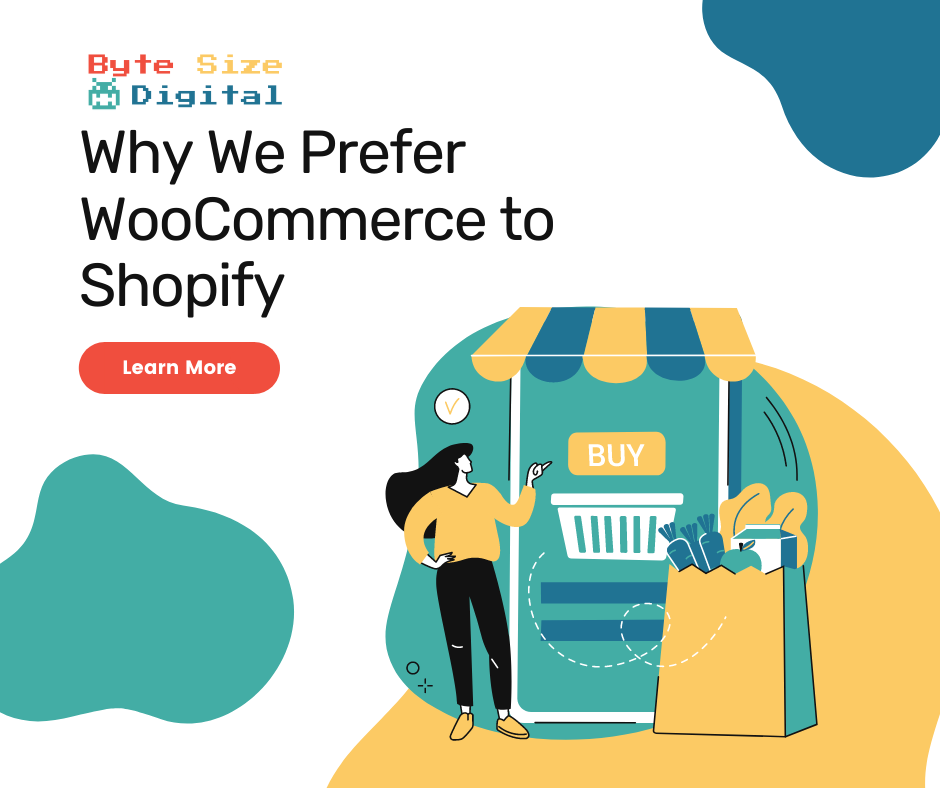Whenever we start an ecommerce project, we always get asked the same two questions. First, what are our thoughts on using Shopify, and second, what makes WooCommerce our preferred e-commerce platform? Honestly, these are great questions and I wanted to take some time to put together a guide on why we use WooCommerce over Shopify.
What they are built for
To start this conversation, we need to look at what the two platforms were built for. Shopify was built for e-commerce. It handles selling things very well. It is optimized for basic e-commerce and was created to be entry level product, order, and shipping management. Pages and blogs were tacked on as a secondary aspect.
WordPress was built as a content management system. It handles SEO, page building, and basics of running a website very well. Writing blogs, building landing pages, adding events, all of this is very straightforward on WordPress.
WooCommerce started out as WooThemes and started building out ecommerce for WordPress sites in 2011. It was only in 2017 that they focused entirely on e-commerce. Woocommerce was designed to be simple out of the box and highly customizable. It is still built on a platform that wasn’t originally created to support e-commerce however.
Where they are weak
So the second part of this question is where each of the platforms lacks. No platform is perfect, and I always tell customers that they need to choose what they want to be frustrated with.
With Shopify, it doesn’t do blogging well at all. It is limited when it comes to SEO, and non-product pages are frustrating to get up and running. In the early days of shopify, it was just a storefront, There wasn’t a robust content management system to create a full fledged website. Building a landing page is hard. For a robust marketing plan, you are going to end up frustrated trying to get all the pieces on your website in place. Also, you are hosting your site on someone else’s platform which means they can dictate what you can and can’t sell, what plugins and scripts you can use, or can take down your store. While it’s rare to run afoul of them. For instance, in 2021 Shopify removed several stores selling merchandise connected to political parties and a few sites that allowed people to upload their own art for printing for violating terms of service.
For WordPress and WooCommerce, while they can do everything Shopify can, there is a very steep learning curve that some people find off putting. The backend management of orders isn’t as sleek as Shopify, and though it has come a long way, it still feels clunky in comparison. Also, woocommerce has not built up the trust and partnerships with shipping companies to get negotiated rates with all the shipping companies or even as many options through their built in shipping management system. There are plugins that offer those same discounts and options, but out of the box it is limited. There are more steps involved to get your site up and running than would be on Shopify.
The nitty gritty about Shopify Vs. WooCommerce
So with all of this in mind, as a company, we sat down to go over the smaller details and decide what we wanted to recommend to people. Since WooCommerce and Shopify have similar functionality, even if WooCommerce does need more set up, it comes down to the marketing and technical aspects. WordPress just makes it easier to make sure SEO is handled correctly, to build landing pages, and to have a robust site that is for more than just online shopping. As our clients grow, we can expand into Membership Sites or Online Learning, and we can easily make changes to the theme or layout of the site.
Lastly, Shopify and WooCommerce use different coding languages. Our developers are more comfortable with tweaking the code as needed in WooCommerce, and aren’t as familiar with the language Shopify is written in. This means if you need your site to be customized, we are more likely to be able to make the changes you want in WooCommerce. We can offer more flexibility there.
We do understand that for some small businesses however, self hosting a site to run WooCommerce might not be what they are looking for. If you don’t have a development team and you are looking to get a shop set up fast and to build your business from there, Shopify would be the better choice for you.
So that is why we chose WooCommerce. If you are interested in learning more about wordpress, head over to the academy where our WordPress 101 course is available to purchase. We walk you through how to use the platform and what woocommerce looks like on the backend. If you have any questions, please feel free to email me at aj@bytesizedigital.com.


